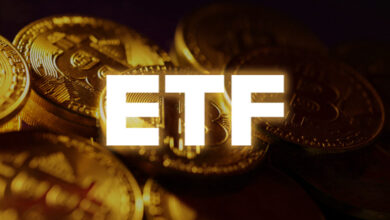Exploring the Controversial Practice of Staking in the Crypto World

Crypto companies providing their clients with extremely high returns through “staking” offerings are facing criticism from the U.S. securities watchdog, who argues that these services should be registered.
On February 9, Kraken, a crypto exchange, agreed to close its staking service for U.S. clients and pay a $30 million fine as part of a settlement with the regulator. This has caused concern among investors that a wider ban on this practice may soon be implemented.
The Concept of Staking in the Cryptocurrency World
Staking refers to a mechanism where cryptocurrency holders choose to participate in verifying transactions on the blockchain network. The verification is carried out by computers on the network, frequently through third-party staking providers.
As a result, validators, who are unable to access the cryptocurrencies used for validation for a specified period, receive a portion of the transaction fees or newly minted tokens.
This reward is then distributed to customers of centralized exchanges who opt to stake their assets.
From a client’s viewpoint, staking allows for the earning of returns on cryptocurrencies by consenting to have them “utilized” or “restricted” for a defined period.
This process is only feasible on blockchains that use the “proof-of-stake” consensus mechanism, such as Ethereum.
The issue facing regulators is whether the reward system resembles a type of investment agreement and should be subject to relevant regulations.
Advantages and Disadvantages of Staking Crypto
While staking offers numerous advantages, it also has its drawbacks. Here, we examine both the pros and cons of staking crypto.
Pros
- Interest Earning: Individuals who stake crypto can earn high yields from the staking rewards, but the process of staking can be complicated. To overcome this, many crypto and DeFi platforms allow users to stake through their services. This means users can earn passive income by just locking away their funds for a specified period. For instance, Mudrex offers up to 10% interest on Vault through staking.
- Energy Efficiency: Proof-of-stake consensus mechanism is more energy efficient compared to proof-of-work. The recent transition of Ethereum from proof-of-work to proof-of-stake significantly reduced its carbon footprint by 99.95%. This means it now consumes power similar to that of a small country.
- Faster and Cheaper Transactions: Transactions in proof-of-stake systems are faster and cheaper. For example, transactions on the Tezos blockchain take around one minute, while those on the Bitcoin network take 1-1.5 hours.
- Potential Voting Rights: By staking their coins, individuals can potentially gain voting rights and participate in deciding changes and upgrades to the blockchain.
Cons
- Inability to trade during the Lock-In Period: one major disadvantage of staking is that you won’t be able to trade your coins during the lock-in period, which is the time frame when your staked crypto is locked in. This can limit your liquidity and affect your ability to access your funds.
- Security concerns: while proof-of-work has been around for over a decade and is considered to be highly secure, proof-of-stake is still relatively new and some experts believe that it sacrifices security for speed. It’s also theorized that an individual or group with enough resources could take control of a proof-of-stake network.
- Centralization issues: Blockchain was designed with the idea of decentralization at its core, but some believe that proof-of-stake could lead to increased centralization. For example, those with more funds may stake more coins, giving them greater control over the network.
Major Crypto Companies Offering Staking Services to Customers
Many of the leading cryptocurrency exchanges, including Coinbase, Binance, Crypto.com, Gemini, Huobi, and OKX, offer staking services to their customers for different tokens.
According to Reuters, these companies offer their clients returns ranging from 2% APY to as high as 40% APY on certain tokens. The most widely staked tokens include Ethereum, Solana, Polygon, and Avalanche.
While centralized exchanges offer staking as a service to their customers, cryptocurrency owners can also stake their tokens on decentralized exchanges like Uniswap, though doing so requires a higher level of technical expertise.
It’s not just crypto companies that offer staking. The British digital banking app Revolut recently started offering its UK and European customers the ability to stake the cryptocurrencies they hold on the platform.
While centralized exchanges offer staking as a service to their customers, cryptocurrency owners can also stake their tokens on decentralized exchanges like Uniswap, though doing so requires a higher level of technical expertise.
SEC’s Concerns with Staking
The SEC’s recent action against Kraken highlights its view that staking is similar to crypto lending, which involved paying high interest rates to crypto depositors for lending their coins.
This practice was targeted by regulators last year, causing several lenders such as Celsius Network and BlockFi to shut down.
The SEC categorizes both crypto lending and staking-as-a-service programs as securities, meaning they are subject to a range of regulatory requirements that were previously thought to not apply to cryptocurrency.
Nevertheless, the determination of whether an asset falls under the purview of the SEC as a security under US rules is based on how closely it resembles company shares being issued for fundraising purposes.
This is determined by applying the Howey test, a legal framework established in a 1946 Supreme Court decision.
As a matter of fact, an asset is considered a security when it meets the criteria of investment funds being put into a shared enterprise with the goal of profiting from the leadership’s efforts.
Staking-as-a-service fits this description, as users deposit their coins with the expectation of generating returns, while the service provider handles the technical aspect.
It is important to note that the designation of staking-as-a-service as a security under US regulations could result in higher operational costs and complexity for providers.
The label entails stringent investor protection and reporting obligations, putting smaller providers at a disadvantage compared to larger ones. Moreover, exchanges that still provide the service may face persistent scrutiny by regulators, leading to potential fines, penalties, and even criminal charges.
This may also cause a decline in future investment from investors wary of increased regulatory compliance and scrutiny. However, proponents of stronger regulation argue that the securities designation will provide more clarity and transparency for investors, thereby attracting more users to the services.
Future of Staking Services in the Cryptocurrency Industry
Despite Gary Gensler‘s statement that the SEC’s settlement with Kraken serves as a warning to the rest of the crypto industry, it remains unclear whether other crypto exchanges that offer staking will register their services with the SEC.
Coinbase has stated that its staking program was not impacted by Kraken’s settlement with the SEC as it is fundamentally different from Kraken’s service.
The Blockchain Association, a trade organization that represents a number of prominent crypto companies in the US, has pointed out that the Kraken settlement is not legally binding and serves as a call to action for Congress to enact legislation to regulate the cryptocurrency industry.





